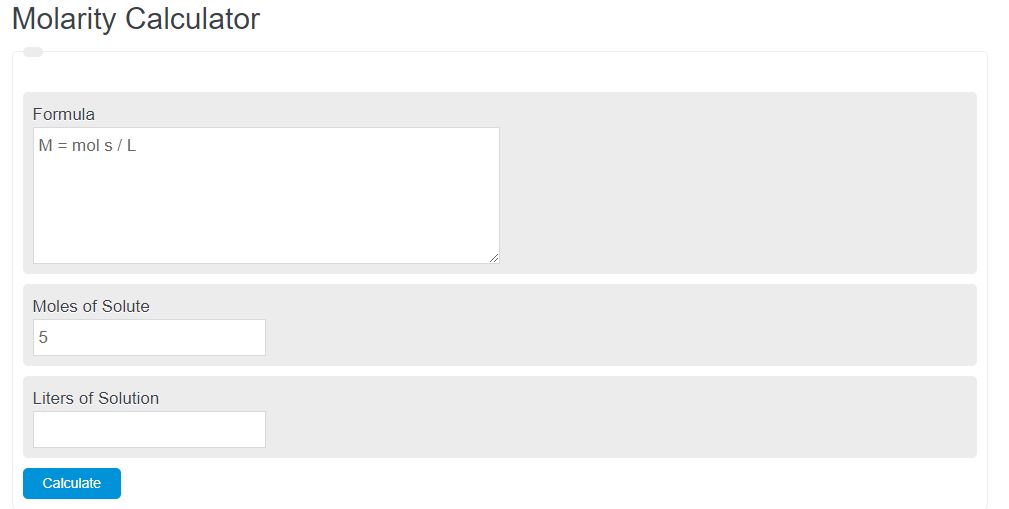Enter the total moles of a solute and the total volume of a solution into the calculator. The calculator will evaluate and display the molarity of the solution. Molarity is also known as molar concentration.
Molarity Formula
The following formula is used to calculate the molarity of a solute in a solution.
M = mol s / L
- Were M is the molarity
- mols s is the total number of moles of solute
- L is the total volume of solution in liters
To calculate molarity, divide the number of moles of solute by the volume of solution in liters.
Molarity Definition
Molarity refers to the concentration of a substance in a solution, specifically the number of moles of solute per liter of solution.
In chemical reactions, molarity helps establish the precise ratio of reactants required for a specific reaction. This information is crucial for balancing equations, predicting product formation, and ensuring the reaction proceeds efficiently.
By knowing the molarity of the reactants, chemists can accurately measure and mix the appropriate volumes to achieve the desired outcome.
Furthermore, molarity aids in determining reaction rates. The rate of a chemical reaction often depends on the concentration of the reactants. By controlling and adjusting the molarity of the reactants, scientists can investigate the effect of concentration on reaction rates and unravel the underlying mechanisms.
Molarity also plays a vital role in stoichiometry, which involves the quantitative relationship between reactants and products in a chemical reaction.
By utilizing molarity, chemists can determine the amount of substance to be used or produced in a reaction, facilitating accurate calculations of masses, volumes, and other important parameters.
How to calculate molarity
Use the following steps to calculate molarity:
- First, measure the total number of moles of solute in the chemical mixture.
- Next, measure the total volume of solution in liters.
- Finally, calculate the molarity using the formula presented above.
FAQ
What is the difference between molarity and molality?
Molarity is the concentration of a solute in a solution expressed as moles of solute per liter of solution. Molality, on the other hand, is the concentration of a solute in a solution expressed as moles of solute per kilogram of solvent. The key difference is that molarity is volume-based, whereas molality is mass-based.
How does temperature affect molarity?
Temperature can affect the molarity of a solution because it can change the volume of the solvent. As temperature increases, the volume of a liquid solvent typically increases, which can decrease the molarity of a solution if the amount of solute remains constant. Conversely, decreasing temperature can increase molarity.
Why is molarity important in chemical reactions?
Molarity is crucial in chemical reactions because it allows chemists to measure precisely how much of a reactant is present in a solution, ensuring the correct stoichiometric ratios are used for the reaction to proceed efficiently. It also helps in predicting product formation, balancing equations, and determining reaction rates.
Can molarity be used for all types of solutions?
Molarity is most commonly used for solutions where the solvent is a liquid and the solute is either a solid, liquid, or gas dissolved in the solvent. However, it is most accurately applied to dilute solutions at or near room temperature, where the volume of the solution does not change significantly with pressure or temperature. For concentrated solutions or those under extreme conditions, other measures of concentration, such as molality, may be more appropriate.

